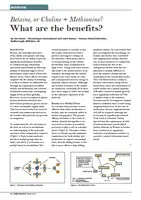Introduction
Betaine, the trimethyl derivative of the amino acid glycine, has long been known for its ability to provide significant performance benefits to commercial pig and poultry operations, particularly by allowing animals to maintain high levels of performance under times of heat and disease stress. These effects of betaine coupled with the ability of including it in diets at almost no additional cost through the replacement of added choline and methionine, has resulted in demand consistently outstripping supply of the product globally. However, recent investment in global betaine production facilities has allowed feed producers greater access to a more sustainable supply chain. This has in-turn resulted in renewed scientific and commercial interest in the benefits this molecule can provide to integrators.
To understand the role of betaine in the feed, as well as its metabolism, an understanding of the molecular structure of the compound is required (Figure 1). Each betaine molecule has three methyl groups that are labile, and allow it to function as a methyl donor in metabolism. The second keypoint to consider is that the betaine molecule has both a positive and negative charge on the molecule, which means that it is non-perturbing to the cellular metabolism when accumulated to high levels. Along with other factors this lends it the characteristics of an osomlyte, meaning that the animal requires less water inside its cells, and consequently uses less energy to maintain osmotic balance. Although the benefits of betaine to the animal are numerous, essentially all of these
have their origin in either the methyl, or the osmolytic capacities of the molecule.
Betaine as a Methyl Donor
As a methyl donor,betaine is more efficient than either methionine or choline, that are routinely added to broiler and pig diets. The greater efficacy of betaine is the result of choline chloride having first to be converted to betaine in metabolic processes to play a role as a methyl donor (Figure 2). Therefore, whilst there is a dietary specific minimum requirement for both choline and methionine to support non-methyl roles, directly adding betaine to the diet is more effective than adding synthetic choline. Several studies that have investigated the interchange of betaine and choline have concluded that supplemental choline chloride can, in most instances, be completely removed from the diet as the endogenous choline from the raw materials is usually sufficient to meet the animal’s choline-specific requirements (for non-methyl needs). This was illustrated by a study in Sweden with broilers using wheatbased diets, where the substitution of 0,03% choline for a similar quantity of Betafin resulted in similar growth, but a significant reduction in FCR. A similar study at the Instituto Internacional de Investgacion Animal, Mexico confirmed these results using sorghum-based diets. In the case of methionine, dietary supplementation will still be required, although the levels may be significantly reduced. Trial work in Istanbul, Turkey showed that the replacement of 20% of total methionine and all added choline chloride by Betaine in broiler diets resulted in no significant reduction in performance relative to a positive control with maize-based diets.
Chemuniqué empowers feed and food producers with the most innovative animal performance solutions, enabling our clients to consistently advance the efficiency of production.










